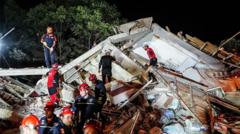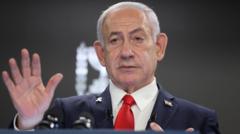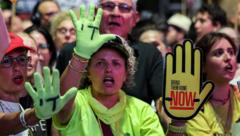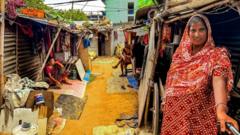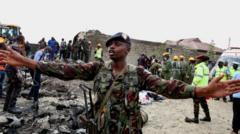Violence erupted in Kenya as citizens rallied against President William Ruto, marking a significant escalation in the ongoing strife between the government and protesters. Medical sources confirm that at least eight people have died, and hundreds more were injured during these nationwide protests, which drew thousands of demonstrators chanting against Ruto's administration.
Kenya Sees Deadly Clashes as Protests Against Government Intensify
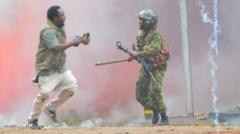
Kenya Sees Deadly Clashes as Protests Against Government Intensify
At least eight fatalities and 400 injuries reported amid nationwide demonstrations against President Ruto.
Authorities responded with force, employing tear gas and water cannons in attempts to disperse the crowd. The protests have seen a prohibition on live broadcast coverage enforced by the government, although this ruling was later lifted by the High Court in Nairobi. In a statement at a funeral in Kilifi county, President Ruto remarked that protests should not undermine the country's peace and urged for a sober approach in addressing grievances.
Demonstrators were again reminded of a violent past, as the protests coincided with the anniversary of last year’s unrest, which claimed at least 60 lives. Reports indicate the gravity of the current situation, with various human rights organizations highlighting the number of injured, among them police officers.
The atmosphere in cities like Nairobi was tense, with barricades deployed across roads leading to government buildings in anticipation of further unrest. Personal accounts from participants like Amina Mude reveal a deep frustration with the government's direction, particularly regarding education and welfare. As visuals of the protests emerged, the symbolic weight of past grievances resonated strongly with demonstrators, many holding mementos of lives lost in previous confrontations.
In light of these developments, Kenyans are calling for a leadership that is willing to listen and respond to their concerns. The protests signify an urgent plea for change as the government grapples with rising discontent among its citizenry.
For more detailed coverage and analysis, visit BBCAfrica.com and follow BBC Africa on social media platforms.
Demonstrators were again reminded of a violent past, as the protests coincided with the anniversary of last year’s unrest, which claimed at least 60 lives. Reports indicate the gravity of the current situation, with various human rights organizations highlighting the number of injured, among them police officers.
The atmosphere in cities like Nairobi was tense, with barricades deployed across roads leading to government buildings in anticipation of further unrest. Personal accounts from participants like Amina Mude reveal a deep frustration with the government's direction, particularly regarding education and welfare. As visuals of the protests emerged, the symbolic weight of past grievances resonated strongly with demonstrators, many holding mementos of lives lost in previous confrontations.
In light of these developments, Kenyans are calling for a leadership that is willing to listen and respond to their concerns. The protests signify an urgent plea for change as the government grapples with rising discontent among its citizenry.
For more detailed coverage and analysis, visit BBCAfrica.com and follow BBC Africa on social media platforms.

